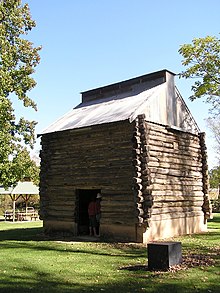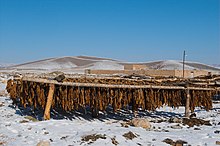Curing of tobacco: Difference between revisions
ClueBot NG (talk | contribs) m Reverting possible vandalism by 72.45.205.3 to version by 92.20.167.146. False positive? Report it. Thanks, ClueBot NG. (1684254) (Bot) |
(edited with ProveIt) |
||
| Line 20: | Line 20: | ||
==Methods== |
==Methods== |
||
Cut plants or pulled leaves are immediately transferred to [[tobacco barn]]s (kiln houses), where they will be cured. Curing methods vary with the type of tobacco grown, and tobacco barn design varies accordingly. |
Cut plants or pulled leaves are immediately transferred to [[tobacco barn]]s (kiln houses), where they will be cured. Curing methods vary with the type of tobacco grown, and tobacco barn design varies accordingly.<ref>{{cite web | url=http://www2.ca.uky.edu/agc/pubs/id/id116/id116.htm | title=Low-Cost Post-Row Field Tobacco Curing Framework | publisher=University of Kentucky | accessdate=6 February 2014}}</ref> |
||
===Air=== |
===Air=== |
||
''Air-cured'' tobacco is hung in well-ventilated barns and allowed to dry over a period of four to eight weeks. Air-cured tobacco is low in sugar, which gives the tobacco smoke a light, sweet flavor, and a high nicotine content. Cigar and [[Burley (tobacco)|burley]] tobaccos are air cured. |
''Air-cured'' tobacco is hung in well-ventilated barns and allowed to dry over a period of four to eight weeks. Air-cured tobacco is low in sugar, which gives the tobacco smoke a light, sweet flavor, and a high nicotine content. Cigar and [[Burley (tobacco)|burley]] tobaccos are air cured.<ref>{{cite web | url=http://www.uky.edu/Ag/TobaccoProd/FactSheets/PDF/Fact%20Sheet%204-09.pdf | title=Burley Tobacco Curing Advisory | publisher=University of Kentucky, College of Agriculture | accessdate=6 February 2014}}</ref> |
||
===Fire=== |
===Fire=== |
||
''Fire-cured'' tobacco is hung in large barns where fires of hardwoods are kept on continuous or intermittent low smoulder and takes between three days and ten weeks, depending on the process and the tobacco. Fire curing produces a tobacco low in sugar and high in nicotine. Pipe tobacco, chewing tobacco, and snuff are fire cured. |
''Fire-cured'' tobacco is hung in large barns where fires of hardwoods are kept on continuous or intermittent low smoulder and takes between three days and ten weeks, depending on the process and the tobacco.<ref>{{cite web | url=http://www.cloudcig.co.uk/switch-to-a-healthier-smoking-option-in-e-cigarettes/ | title=Switch To A Healthier Smoking Option In E-cigarettes | accessdate=6 February 2014}}</ref> Fire curing produces a tobacco low in sugar and high in nicotine. Pipe tobacco, chewing tobacco, and snuff are fire cured. |
||
===Flue=== |
===Flue=== |
||
''Flue-cured'' tobacco was originally strung onto tobacco sticks, which were hung from tier-poles in curing barns (Aus: [[kiln]]s, also traditionally called [http://education.yahoo.com/reference/dictionary/entry/oast oasts]). These barns have flues which run from externally fed fire boxes, heat-curing the tobacco without exposing it to smoke, slowly raising the temperature over the course of the curing. The process will generally take about a week. This method produces cigarette tobacco that is high in sugar and has medium to high levels of nicotine. The [[Smith Tobacco Barn]] is an example of a traditional, flue-cured tobacco barn. |
''Flue-cured'' tobacco was originally strung onto tobacco sticks, which were hung from tier-poles in curing barns (Aus: [[kiln]]s, also traditionally called [http://education.yahoo.com/reference/dictionary/entry/oast oasts]). These barns have flues which run from externally fed fire boxes, heat-curing the tobacco without exposing it to smoke, slowly raising the temperature over the course of the curing. The process will generally take about a week. This method produces cigarette tobacco that is high in sugar and has medium to high levels of nicotine. The [[Smith Tobacco Barn]] is an example of a traditional, flue-cured tobacco barn.<ref>{{cite web | url=http://pubs.ext.vt.edu/436/436-048/PDF_61-64CuringTobacco.pdf | title=Flue-cured Tobacco Curing | publisher=Virginia Polytechnic Institute and State University | accessdate=6 February 2014 | author=T. David Reed}}</ref> |
||
===Sun=== |
===Sun=== |
||
Revision as of 10:45, 6 February 2014
| Part of a series on |
| Tobacco |
|---|
 |
After tobacco has been harvested, it is necessary to cure it before consumption.
History

Curing tobacco has always been a process necessary to prepare the leaf for consumption. In recent time traditional curing barns in the U.S. are falling into disuse, as the trend toward using prefabricated metal curing boxes. Temporary curing boxes are often found on location at tobacco farms.
Processes


Curing and subsequent aging allow for the slow oxidation and degradation of carotenoids in the tobacco leaf. This produces various compounds in the tobacco leaves that give cured tobacco its sweet hay, tea, rose oil, or fruity aromatic flavor that contributes to the "smoothness" of the consumed product. Non-aged or low quality tobacco is often artificially flavored with these otherwise naturally occurring compounds. Tobacco flavoring is a significant source of revenue for the international multi-million dollar flavor and fragrance industry.
The aging process continues for a period of months and often extends into the post-curing harvest process.
After tobacco is cured, it is moved from the curing barn into a storage area for processing. If whole plants were cut, the leaves are removed from the tobacco stalks in a process called stripping. For both cut and pulled tobacco, the leaves are then sorted into different grades. In colonial times, the tobacco was then "prized" into hogsheads for transportation. In bright tobacco regions, prizing was replaced by stacking wrapped "hands" into loose piles to be sold at auction. Today, most cured tobacco is baled before sales are made under pre-sold contracts.
Methods
Cut plants or pulled leaves are immediately transferred to tobacco barns (kiln houses), where they will be cured. Curing methods vary with the type of tobacco grown, and tobacco barn design varies accordingly.[1]
Air
Air-cured tobacco is hung in well-ventilated barns and allowed to dry over a period of four to eight weeks. Air-cured tobacco is low in sugar, which gives the tobacco smoke a light, sweet flavor, and a high nicotine content. Cigar and burley tobaccos are air cured.[2]
Fire
Fire-cured tobacco is hung in large barns where fires of hardwoods are kept on continuous or intermittent low smoulder and takes between three days and ten weeks, depending on the process and the tobacco.[3] Fire curing produces a tobacco low in sugar and high in nicotine. Pipe tobacco, chewing tobacco, and snuff are fire cured.
Flue
Flue-cured tobacco was originally strung onto tobacco sticks, which were hung from tier-poles in curing barns (Aus: kilns, also traditionally called oasts). These barns have flues which run from externally fed fire boxes, heat-curing the tobacco without exposing it to smoke, slowly raising the temperature over the course of the curing. The process will generally take about a week. This method produces cigarette tobacco that is high in sugar and has medium to high levels of nicotine. The Smith Tobacco Barn is an example of a traditional, flue-cured tobacco barn.[4]
Sun
Sun-cured tobacco dries uncovered in the sun. This method is used in Turkey, Greece, Bulgaria, Macedonia, Romania and Mediterranean countries to produce oriental tobacco. Sun-cured tobacco is low in sugar and nicotine and is used in cigarettes. In India sun curing is used to produce so-called "white" snuffs, which are fine, dry, and unusually potent.
See also
This section is empty. You can help by adding to it. (September 2013) |
References
- ^ "Low-Cost Post-Row Field Tobacco Curing Framework". University of Kentucky. Retrieved 6 February 2014.
- ^ "Burley Tobacco Curing Advisory" (PDF). University of Kentucky, College of Agriculture. Retrieved 6 February 2014.
- ^ "Switch To A Healthier Smoking Option In E-cigarettes". Retrieved 6 February 2014.
- ^ T. David Reed. "Flue-cured Tobacco Curing" (PDF). Virginia Polytechnic Institute and State University. Retrieved 6 February 2014.
Notes
This section is empty. You can help by adding to it. (September 2013) |
Bibliography
This section is empty. You can help by adding to it. (September 2013) |
Further reading
This section is empty. You can help by adding to it. (September 2013) |
